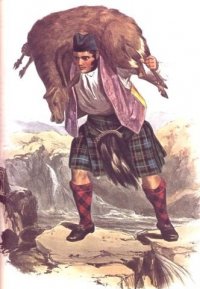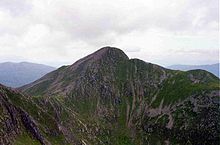Clan Macrae
| Clan MacRae | |||
|---|---|---|---|
 Crest:A cubit arm grasping a sword all Proper | |||
| Motto | Fortitudine | ||
| Slogan | Sgùrr Uaran | ||
| Profile | |||
| Region | Scottish Highlands | ||
| District | Wester Ross Sutherland | ||
| Plant badge | Club moss | ||
 | |||
| Clan MacRae no longer has a chief, and is anarmigerous clan | |||
| Historic seat | Eilean Donan | ||
| Last Chief | MacRae of Inverinate | ||
| |||
| |||
TheClan Macraeis a HighlandScottish clan.The clan has no chief; it is therefore considered anarmigerous clan.
Surname[edit]
The surname Macrae (and its variations) is ananglicisationof thepatronymicfrom theGaelicpersonal nameMacRaith.Thispersonal namemeans "son of grace".[1]
Traditional origins of the clan[edit]
According to the late 19th-century historianAlexander Mackenzie,andRev.Alexander Macrae in the early 20th century, the main authority for the early history of Clan Macrae is the late 17th-centurymanuscriptaccount of the clan written by Rev. John Macrae.[2][3]Alexander Macrae largely based his history of the clan upon John Macrae's earlier account.[4]
According to tradition, the Macraes were originally from Ireland and shared a common ancestry with theMackenziesandMacleans.The Macraes were said to have originated from Clunes, which is located near the southern shore of theBeauly Firth,and was within the lordship of Lovat. Alexander Macrae stated that these traditions likely refer to a period sometime in the middle of the 13th century.[5]
According to John Macrae, after a violent dispute arose between the Macraes and more powerfulFrasers of Lovat,three sons of the Macraechiefset off for new lands. One of the sons settled in Brahan, near Dingwall (later the site ofBrahan Castle); another settled inArgyll;and the other settled inKintail.[3]

At that time Kintail was held by the Mackenzies, and according to John Macrae's account, there were very few Mackenzies of the chiefly line and thus the chief of that clan welcomed the Macraes because they shared a common descent and could be relied upon. Although John Macrae did not know the name of the Macrae brother who settled in Kintail, he stated that this Macrae brother married the daughter, or granddaughter, of Macbeolan who possessed a large part of Kintail before Mackenzie's rise to power.[note 1]Alexander Mackenzie considered this marriage to be the real reason for the loyalty given by the Macraes to their Mackenzie lords; he did not believe the Macraes and Mackenzies to share a common ancestry in themale lineas John Macrae had claimed.[3]

Alexander Macrae was of the opinion that these events probably took place sometime in the first half of the 14th century before the Mackenzies became firmly established in the Kintail area. He stated that there didn't appear to be any evidence that the Macraes were in the Kintail area before the time of these events, but noted that it was said thatEilean Donan Castlewas garrisoned by Macraes andMaclennansin the late 13th century, during the period when the fortress was first taken into possession by Kenneth, founder of the Mackenzies of Kintail.[5]
According to tradition, one of the prominent ancestors of the Macraes from Kintail wasFionnla Dubh mac Gillechriosd,According to John Macrae, Fionnla Dubh mac Gillechriosd was about two, or three, generations removed from the Macrae who settled in Kintail from Clunes. Alexander Macrae stated that Fionnla Dubh was a contemporary of Murdo Mackenzie, fifthchief of the Mackenzies of Kintail.In 1416, Murdo died and was succeeded by his son,Alexander.[7]
According to the traditions of John Macrae, when thebastarduncles of the young Mackenzie chief began oppressing the folk of the district, Fionnla Dubh was instrumental in retrieving him from the south of Scotland; upon Alexander's return, the Mackenzie lands were brought back under control. The main line of the Macraes from Kintail, the Macraes of Inverinate, trace their descent from Fionnla Dubh.[7]
History[edit]



The Macraes are known to have been constant supporters of theClan Mackenziein recorded times; in 1520, and for many years onwards, they wereconstablesofEilean Donan Castle.[8]In 1539 theClan Macdonald of Sleatbesieged Eilean Donan as part of their attempt to restore theLordship of the Islesand Duncan Macrae is credited with slaying the Macdonald chief with an arrow which brought the siege to an end.[9]In view of their constant service to the Mackenzies, the Macraes of Kintail became known as the Mackenzies' "shirt ofmail".[3]
17th century and civil war[edit]
The Rev. Farquhar Macrae, born in 1580, Constable of Eilean Donan, was both an energetic churchman and a great Latin scholar. On his first visit to the Isle of Lewis, he is said to have baptised all the inhabitants under forty years of age, no clergyman having resided on the island during that period. His second son, John Macrae, became minister ofDingwallin 1640 and died in 1704.
During the Civil War the Clan Macrae supported theRoyalistcause but under the equivocating Earl of Seaforth firstly fought valiantly on the losing Stateside at theBattle of Auldearnin May 1645 before following Seaforth to support the royalistJames Graham, 1st Marquess of Montrose.
Rev. Farquhar Macrae's grandson,Duncan Macrae of Inverinatewas the compiler of the famousFernaig manuscript1688-93.[10]
Jacobite risings[edit]
In 1721 William Ross, 6th chief of the Pitcalnie line, his brother, Robert Ross, and a force of their clansmen tried to levy rents in theClan Mackenzielands, but were confronted by Colonel Donald Murchison and three hundred Mackenzies and Macraes. Both Walter Ross, the chief's son, and Robert's son, William, were wounded[11]in the shortBattle of Glen Affric,and the outnumbered Rossesparleyedand withdrew. Walter died of his wounds the next day.
In theJacobite rising of 1745,the Macraes were divided. A number are known to have sided with the Jacobites underGeorge Mackenzie, 3rd Earl of Cromartie,while others joined the government'sIndependent Highland Companiesunder Captain Colin Mackenzie[12]In June 1746 the Mackenzie Company at Shiramore in Badenoch had over sixty Macraes,[13]including anEnsignJohn MacRae.
American Revolution[edit]
At the outbreak of theAmerican Revolution,many members of Clan Macrae who had settled along theCape Fear Riverin theColony of North Carolina,rose up and fought under the command of Brigadier General Donald MacDonald asLoyalistsat theBattle of Moore's Creek Bridge.Among them was thewar poetJohn MacRae,who has been termed one of the "earliestScottish Gaelicpoets inNorth Americaabout whom we know anything. "[14]
MacRae was taken prisoner byPatriotmilitia following the Loyalist defeat. His son Murdo was mortally wounded.[15]
Even though John MacRae is believed to have been killed either during or soon after theBattle of King's Mountainin 1780, his poems and songs celebrating the Loyalist cause remain an important part ofScottish Gaelic literatureand are equally popular among speakers ofCanadian Gaelic.[15]
In more recent interviews withJohn Lorne Campbell,BarraseanchaidhJohn The Coddy MacPherson recalled that Clan Macrae ofKintailwere famous throughout Scotland for cooking high qualitymoonshine,or "peatreek" inScots,from illegalpot stills(Scottish Gaelic:poit dhubh).[16]
Symbols[edit]
Clan crests,clan badges,andclan tartansare means of identifying and displaying members' allegiance to their clan.
Macraes may wear on abonnetor upon the chest either a badge of the Crest,A cubit arm grasping a sword, all proper.[17]encircled by a strap with the Latin mottoFORTITUDINE,meaning "with fortitude";,[17]or the more authentic plant badge of a real sprig ofclub moss.[18]sometimes referred to asstaghorn grass.It may refer to the Mackenzie chief's arms, since the Macraes proudly admit no chief of their own but are closely associated with the Mackenzies.[18]
The clan's war crySgurr Uaranrefers toSgùrr Fhuaran,a mountain nearLoch Duichwhich is one of the "Five Sisters of Kintail",[19]and a prominent rallying point in the clan's traditional lands.
"In Flanders Fields"was scribbled by a Canadianwar poetof Scottish descent, Lieutenant-ColonelJohn McCrae,following the death of a close friend on theWestern Frontduring theFirst World War.He threw it away, but one of his orderlies retrieved it for posterity.
A 2/4 March for bagpipes has been composed in honour of Clan Macrae.[20]
Notes[edit]
- ^Forms of the nameMacbeolan,orO'beolan,were applied to describe the earlyearls of Ross;however, according to historian Alexander Grant, the Gaelic nameBeólan,meaning "little mouth", was fairly common and may have been used as anickname.Grant stated that theMacbeolanreferred to in Macrae tradition does not necessarily refer to the Earls of Ross.[6]
References[edit]
- ^"McRae Name Meaning and History".Ancestry.Retrieved14 August2008.
- ^Macrae, Alexander (1910)."History of the Clan Macrae with genealogies".Dingwall:George Souter: 12–13.
{{cite journal}}:Cite journal requires|journal=(help) - ^abcdMackenzie, Alexander (1894).History of the Mackenzies: With Genealogies of the Principal Families of the Name(New, revised, extended ed.).Inverness:A. & W. Mackenzie. pp.65–67.
- ^Macrae, Alexander (1910)."History of the Clan Macrae with genealogies".Dingwall:George Souter: vi.
{{cite journal}}:Cite journal requires|journal=(help) - ^abMacrae, Alexander (1910)."History of the Clan Macrae with genealogies".Dingwall: George Souter: 4–8.
{{cite journal}}:Cite journal requires|journal=(help) - ^Grant, Alexander (2000). "The Province of Ross and the Kingdom of Alba". InCowan, Edward J.;McDonald, R. Andrew (eds.).Alba: Celtic Scotland in the Middle Ages.East Linton: Tuckwell Press. p. 119.ISBN1-86232-151-5.
- ^abMacrae, Alexander (1910)."History of the Clan Macrae with genealogies".Dingwall: George Souter: 14–16.
{{cite journal}}:Cite journal requires|journal=(help) - ^Adam, Frank (1970). "The clans, septs and regiments of the Scottish Highlands" (8th ed.). Edinburgh: Johnson and Bacon: 272–273.
{{cite journal}}:Cite journal requires|journal=(help) - ^Way, George and Squire, Romilly.Collins Scottish Clan & Family Encyclopedia.(Foreword by The Rt Hon. The Earl of Elgin KT, Convenor, TheStanding Council of Scottish Chiefs). Published in 1994. Page 426–427.
- ^MacPharlain, Calum Lamh-Sgrìobhainn Mhic Rath, (Dundee)
- ^McKenzie, Alan."History of the Mackenzies"(PDF).Clan MacKenzie Society in the Americas – Canadian Chapter: 143.
{{cite journal}}:Cite journal requires|journal=(help) - ^Simpson, Peter. (1996).The Independent Highland Companies, 1603–1760.ISBN0-85976-432-X.pp. 127 – 128 and 130.
- ^"THE INDEPENDENT COMPANIES".Clan Macrae Scotland.Retrieved26 May2009.
- ^Edited by Natasha Sumner andAidan Doyle(2020),North American Gaels: Speech, Song, and Story in the Diaspora,McGill-Queen's University Press, pg. 14.
- ^ab"MacRae, John | NCpedia".ncpedia.org.
- ^The Coddy (2001),Tales from Barra,Birlinn Limited,pages 73-75.
- ^abWay; Squire (2000), p. 230.
- ^abAdam; Innes of Learney (1970), pp. 541–543.
- ^"SGURR UARAN".Clan Macrae Scotland (clan-Macrae.org.uk).Retrieved21 June2008.
- ^Archie Cairns – Book 1 Pipe Music 'Clan MacRae Society' 2/4 March 1995
- Bain, Robert; Stewart-Blacker, P. E. (1983). MacDougall, Margaret O. (ed.).The Clans and Tartans of Scotland.Glasgow: Collins.ISBN0-00-411117-6.
- Way of Plean, George;Squire, Romilly (2000).Clans & Tartans.Glasgow: HarperCollins.ISBN0-00-472501-8.
- Bush, Cornelia (2006).MacRaes to America!!.Chapel Hill NC: Chapel Hill Press.ISBN978-1-59715-025-5.
External links[edit]
- http:// clan-macrae.org.uk/Clan Macrae Scotland
- https:// clanmacraecanada.ca/Clan MacRae Society of Canada
- http:// macrae.org/Clan MacRae Society of North America
